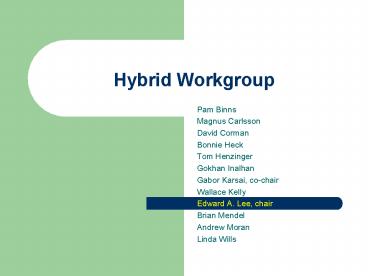Hybrid Workgroup - PowerPoint PPT Presentation
1 / 23
Title:
Hybrid Workgroup
Description:
Free flight conflict avoidance (Rockwell) Platooning vehicles (Berkeley) Dragonfly Multi-vehicle coord (Stanford) ... history? no. What is a Domain ... – PowerPoint PPT presentation
Number of Views:39
Avg rating:3.0/5.0
Title: Hybrid Workgroup
1
Hybrid Workgroup
- Pam Binns
- Magnus Carlsson
- David Corman
- Bonnie Heck
- Tom Henzinger
- Gokhan Inalhan
- Gabor Karsai, co-chair
- Wallace Kelly
- Edward A. Lee, chair
- Brian Mendel
- Andrew Moran
- Linda Wills
2
Modeling Questions
- Language (syntax, semantics, composition)
- Modeling a distributed physical plant
- Modeling the controller
- Modeling faults and their effects
- How are models used?
- Semantics of anytime computation
3
Uses of Hybrid Systems
- Analysis
- Analysis of discrete and continuous controllers
interacting with a continuous plant - Simulation
- Evaluation of continuous models with discrete
mode transitions - Embedded modeling
- Embedding of continuous models in deployed
systems, integrated into the control algorithms
(e.g. for fault identification)
4
Questions
- What's in the OCP, and what's in the application?
- Run-time support for hybrid models? at what cost?
- Design-time support? (e.g. generation of
software) - Anytime computation? (resource management)
- QoS guarantees? Is real-time O/S the only
option? - Admission control?
- Support for domain-specific languages?
5
Examples Considered
- UAV helicopter control (GATech)
- Free flight conflict avoidance (Rockwell)
- Platooning vehicles (Berkeley)
- Dragonfly Multi-vehicle coord (Stanford)
- In all cases, we talked about fault detection
and adaptation using modal control.
6
Mode Transition Control (GATech)Overall
Architecture
Goal Mode
Mission
Situation
Mode
Planning
Awareness
Selection
Transition
Transition
Start Flag
Complete Flag
MTC 1
Mode
Flight
MTC 2
Transition
Controller
Manager
MTC N
Mode Transition
Controllers
Mode Transition Control Manager
Helicopter States
7
Mode Transition Specification
Mode
Mode
Desired
1
2
Goal Mode
Transition
Complete Flag
Transition
Mode
N
Start Flag
---- denotes a transition from
Mode
to
Mode
i
j
---- denotes a regulation about
Mode
i
8
FDI/FTC Demo in OCP (GATech)
Indicates separate OCP components
HighLevel
Fault TolerantControl Manager
Fault Detection Identification
MidLevel
ReconfigurationController
RedistributionController
Set-PointController
Interconnection Structure
v1
LowLevel
Subsystem
Subsystem
y1
r1
e1
Local Controller
Local Controller
9
Free Flight (Rockwell)
10
Extensions
- UCAVs with accurate models of one another
coordinated maneuvers rather than assuming the
other aircraft will not react. - Errors in transmission, faulty/damaged UCAVs
fault identification and adaptation. - Create hybrid automaton model and use hybrid
Mocha to verify that conflicts do not occur.
11
Scenario Vehicle Tracking
Event Channel
- Publishes
- time
- driving force
- velocity
- position
Subscribes
- Implements
- fault detection
- modal control
12
Modeling Car Tracking
Java Space (today) OCP (tomorrow)
thanks to Jie Liu and Xiaojun Liu
13
Execution
14
OCP here only?
Hierarchical View
leader
follower
sensors
actuators
controller
Br
Acc
Ba
S
PID
bang-bang
15
Styles of Publish and Subscribe Interactions
- time stamped events?
- globally time stamped?
- reliable delivery?
- ordered delivery?
- signal coordination?
- synchronous delivery?
- blending of multiple publishers?
- dynamic redirection/resourcing?
- persistence?
- history?
16
OCP Domain 1
- time stamped events? yes
- globally time stamped? no
- reliable delivery? yes
- ordered delivery? no
- signal coordination? yes
- globally synchronous delivery? no
- blending of multiple publishers? no
- dynamic redirection/resourcing? yes
- persistence? no
- history? no
17
What is a Domain
- The definition of the interaction of components,
and the software that supports this interaction. - Multi-domain modeling means
- Hierarchical composition
- heterogeneous models allowed
- Domains can be specialized
- avoid creeping featurism
- enable verification
- Data replication in OCP/Boldstroke is another
domain - separation of communication mechanisms.
18
What technology can be shared when building
domains?
- Abstract syntax
- Type systems
- Components
- Interfaces
19
Domains After Domain 1
- High-sample-rate, periodic event handling
- Stream-based component interaction
- Control reconfiguration management
- Time-triggered, synchronous modeling
- Continuous-time domain
- Domains need to be able to
- Share a consistent notion of time
- Share signals/params across levels of the
hierarchy. - Export interfaces to other domains
- Import components designed in another domain
20
Milestones
- Use OCP in demonstrations in each of
- Active state models
- On-line control customization
- Coordinated multi-modal control
- Steps
- Define the challenge problems that justify
domains. - Work out how mode transitions and other control
reconfiguration are handled in the OCP. - Work out the interaction semantics (domains)
supported by the OCP (mode transition control?
continuous modeling? synchronous interactions?)
21
Architecture to Avoid
Poor common infrastructure. Weak
specialization. Poor resource management and
sharing. Poor planning.
22
Also to Avoid
Elegant, unified, and beautiful, but rigid,
inflexible, and difficult to adapt. Plus, it
takes 100 years to build.
23
Elegant Federation
Elegant federation of heterogeneous models.































